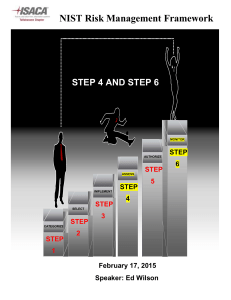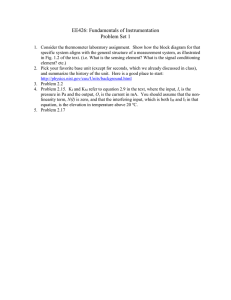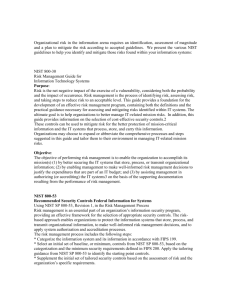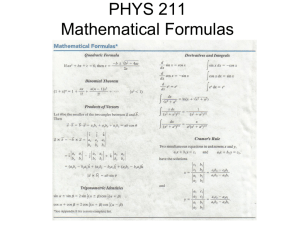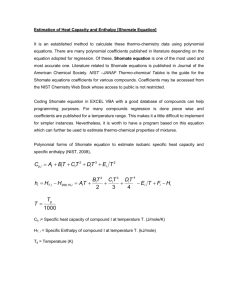NIST Report to the American Association of Physicists in Medicine: and
advertisement
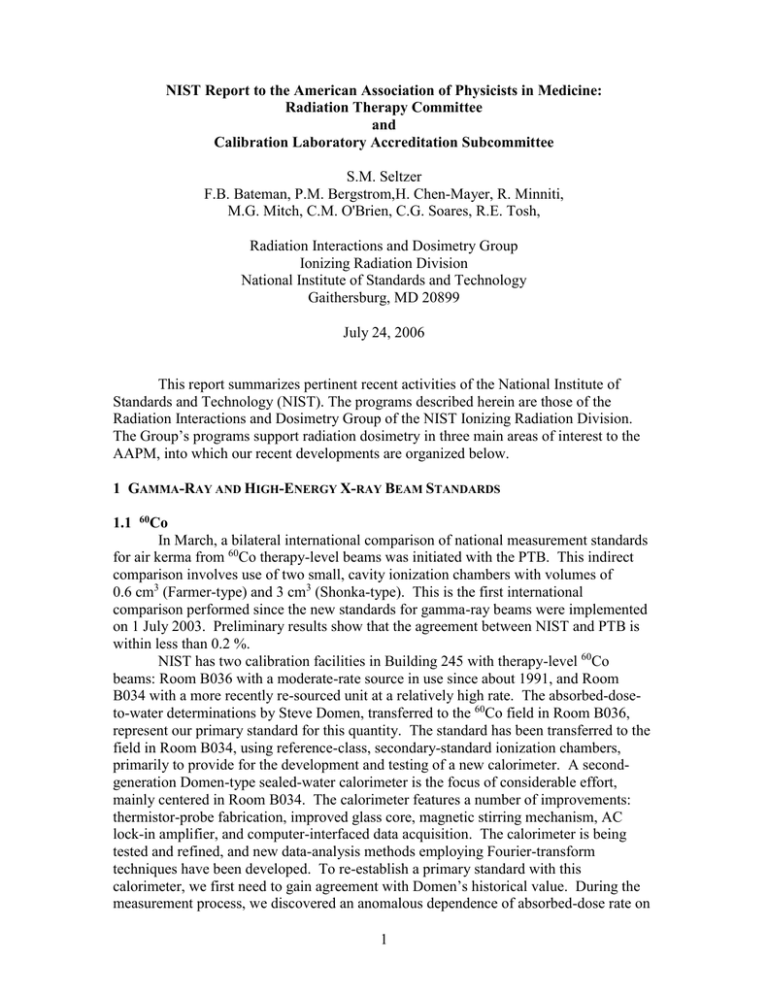
NIST Report to the American Association of Physicists in Medicine: Radiation Therapy Committee and Calibration Laboratory Accreditation Subcommittee S.M. Seltzer F.B. Bateman, P.M. Bergstrom,H. Chen-Mayer, R. Minniti, M.G. Mitch, C.M. O'Brien, C.G. Soares, R.E. Tosh, Radiation Interactions and Dosimetry Group Ionizing Radiation Division National Institute of Standards and Technology Gaithersburg, MD 20899 July 24, 2006 This report summarizes pertinent recent activities of the National Institute of Standards and Technology (NIST). The programs described herein are those of the Radiation Interactions and Dosimetry Group of the NIST Ionizing Radiation Division. The Group’s programs support radiation dosimetry in three main areas of interest to the AAPM, into which our recent developments are organized below. 1 GAMMA-RAY AND HIGH-ENERGY X-RAY BEAM STANDARDS 1.1 60Co In March, a bilateral international comparison of national measurement standards for air kerma from 60Co therapy-level beams was initiated with the PTB. This indirect comparison involves use of two small, cavity ionization chambers with volumes of 0.6 cm3 (Farmer-type) and 3 cm3 (Shonka-type). This is the first international comparison performed since the new standards for gamma-ray beams were implemented on 1 July 2003. Preliminary results show that the agreement between NIST and PTB is within less than 0.2 %. NIST has two calibration facilities in Building 245 with therapy-level 60Co beams: Room B036 with a moderate-rate source in use since about 1991, and Room B034 with a more recently re-sourced unit at a relatively high rate. The absorbed-doseto-water determinations by Steve Domen, transferred to the 60Co field in Room B036, represent our primary standard for this quantity. The standard has been transferred to the field in Room B034, using reference-class, secondary-standard ionization chambers, primarily to provide for the development and testing of a new calorimeter. A secondgeneration Domen-type sealed-water calorimeter is the focus of considerable effort, mainly centered in Room B034. The calorimeter features a number of improvements: thermistor-probe fabrication, improved glass core, magnetic stirring mechanism, AC lock-in amplifier, and computer-interfaced data acquisition. The calorimeter is being tested and refined, and new data-analysis methods employing Fourier-transform techniques have been developed. To re-establish a primary standard with this calorimeter, we first need to gain agreement with Domen’s historical value. During the measurement process, we discovered an anomalous dependence of absorbed-dose rate on 1 radiation exposure time, which can be explained by heat-conduction effects. This implicates the overall confidence of accurate dose determination using water calorimeters of a similar design. Over the preceding year, efforts have been directed toward developing accurate models of heat transfer, principally conduction, within the phantom and the glass core, with the goal of characterizing its dependence upon physical characteristics of the calorimeter (e.g., geometry of the glass core, thermal diffusivities of glass and water). This work has involved a combination of analytical and finite-element methods and experimental testing of a new core developed by Steve Domen. Essential features of the systematic error caused by heat conduction are now well understood, but additional work will be needed to characterize experimentally observed artifacts with the desired accuracy and precision. Summaries of this work will be presented at this AAPM meeting via poster SU-FF-T-392 and talk TU-C-224C-10. In addition, we have begun to test a sealed-water calorimeter that uses ultrasound, instead of thermistors, to sense changes in water temperature. This technology would, in principle, eliminate conduction artifacts that originate from non-water materials in the phantom. The work is a joint effort of NIST and Luna Technologies, LLC., and one of their representatives will be summarizing it in talk TH-E-224A-5. 1.2 Accelerator facilities The refurbished Varian Clinac 2100C radiotherapy accelerator installed in a special bunker can produce electron beams of 6, 9, 12, 16 and 20 MeV and photon beams of 6 and 18 MV at dose rates from 80 to 400 cGy/min at 1 meter SSD. The facility continues to be used in measurements and testing of our second-generation Domen-type sealed-water calorimeter. We are currently conducting a series of photon depth-dose and beam-profile measurements in water using a 3D radiation scanning system. These measurements will be used as benchmark data and will help in comparisons with results from detailed Monte Carlo simulations of the accelerator. Our future goals include the establishment of a primary calibration laboratory for high-energy medical dosimetry based on this accelerator. The Monte Carlo simulations use details of the Clinac 2100C provided by Varian, along with other information available in the literature, to develop a model of the accelerator as a source of photons, and then calculates the dose distributions in water. It is expected that utilizing a coupled approach of comparing measurement to calculation and adjusting calculational details (e.g., beam energy) will lead to an accurate model, which will provide tools for a more accurate realization of absorbed dose with the water calorimeter. 2 BRACHYTHERAPY STANDARDS 2.1 Prostate seed calibrations NIST has calibrated more than 700 prostate brachytherapy seeds since January 1999 in terms of air-kerma strength using the Wide-Angle Free-Air Chamber (WAFAC). A total of 33 seed designs from 18 manufacturers have a NIST-traceable air-kermastrength calibration. Quality-assurance and characterization measurements performed at NIST include well-chamber response, x-ray spectrometry, in-air anisotropy, and radiochromic-film contact exposures. The in-air anisotropy of seeds is studied by taking x-ray spectrometry measurements at discrete rotation angles about the axis perpendicular to the mid-point of the long axis of the seed. The "air-anisotropy ratio", calculated from the results of such angular x-ray measurements, has proven to be a useful parameter for 2 explaining differences in well-chamber response observed for different seed models having the same emergent spectrum on their transverse axis. The results of these various characterization measurements continue to assist in the resolution of discrepancies in airkerma strength measurements between NIST, the ADCLs, and seed manufacturers. Long-term stability of the standard measurement system is monitored by periodic constancy checks of the WAFAC response to a ≈150 MBq 241Am source mounted on the filter/shutter wheel that can be rotated into a reproducible position. This and the redundancy checks made with the variety of house well-ionization chambers ensure against any shifts in air-kerma-strength determinations. 2.2 Proficiency and MQA tests An MQA test for brachytherapy involving NIST and the University of Wisconsin, K&S, and MD Anderson ADCLs has been completed. The scope of the test included determination of well chamber calibration coefficients for an LDR 192Ir seed and a 137Cs tube source for a chamber supplied by the University of Wisconsin ADCL. The test was completed and reports sent to all participants by the end of January 2006. 2.3 Beta-Particle Brachytherapy-Source Calibration Techniques for source calibration and uniformity characterization have been developed in the past employing a variety of measurement systems. A reference value of the absorbed-dose rate to water at a 2 mm depth in water-equivalent plastic is determined with the NIST medical extrapolation chamber equipped with a 1 mm diameter collecting electrode. Calibrated radiochromic-dye film, read out with high-resolution scanning densitometry is used both to confirm the extrapolation chamber measurements and to provide information on the spatial distribution of absorbed-dose rate around the source. Additional confirmatory measurements are preformed on each source with calibrated well-ionization chambers and a calibrated scintillator system. A comparison of beta-particle brachytherapy dosimetry is in progress between NIST and PTB in Germany, using a reference 90Sr/Y line source imbedded near the surface of an Al block. The results of this comparison, hosted by the PTB, have not yet been released. In June 2004 an International Organization for Standardization (ISO) New Work Item Proposal (NWIP) was approved on clinical dosimetry of beta-particle brachytherapy sources. The draft, now in the CD stage, is available from Chris Soares, and interested parties are invited to participate in this development, which is currently taking place within the new working group 22 (Radiation Protection for Medical Protocols) within subcommittee 2 (Radiation Protection) of technical committee 85 (Nuclear Energy). Ideas for other NWIPs in clinical dosimetry are being solicited. 2.4 Characterization of Miniaturized X-Ray Brachytherapy Source Measurements of air kerma from Xoft’s Axxent Electronic Brachytherapy System were conducted in support of their FDA submission and research by Steve Davis of the University of Wisconsin. After attempts with the NIST WAFAC, two x-ray free-air ionization chambers (FACs) were used for this effort. The goal of the work is to achieve reproducible air-kerma measurements with both FACs and allow the value to be transferred to a well chamber. The success of the determination of air-kerma is highly dependent on the geometry, scatter conditions and stability of the source. Additional 3 measurements are required at NIST to determine the air-kerma and the associated uncertainty. 3 DIAGNOSTIC X RAYS The proficiency test for the MQSA program is in progress and will compare the results for UW and K&S for the Mo/Mo28 and Mo/Mo30 beam. A new tube, identical to the previous 320 kV x-ray tube was replaced in May 2006. The processed chilled water, used at NIST for years, corroded the water-to-oil heat exchanger and allowed the water to mix with the oil, destroying the system. The problem was not evident from the three flow and temperature interlocks or the routine maintenance of the heat exchanger. Both voltage dividers have been repaired and are now being used to verify the operating voltage of the system. A measurement comparison with the PTB in Germany began in March and will compare the values of air-kerma as measured by various ionization chambers for mammography energies and all the low-energy international CCRI beams. This will be the third indirect comparison with PTB for mammography since 1995; an effort agreed upon between the labs to ensure quality, since traceability is not yet available through the BIPM for mammography. This will be the first comparison between the labs for the newly established CCRI beams at NIST. This comparison will facilitate the preparations for future comparisons (2008) with the BIPM for these low-energy qualities. Our policy on proficiency testing has been clarified to facilitate increased understanding of the procedures, and is given below: General Guidelines for NIST Proficiency Tests Offered for X-Ray and GammaRay Air-Kerma Traceability 1. The calibration facility shall initiate contact with NIST and request a proficiency test for the reference radiation qualities within their scope of accreditation. 2. NIST will calibrate a NIST reference-class, transfer ionization chamber using mutually decided upon reference radiation qualities. NIST will then send the transfer standard to the participating calibration facility, along with a proficiencytest protocol, describing the details of the NIST calibration conditions and the required dates and addresses for the proper shipment of the chamber. The NIST calibration results for the chamber are not revealed to the test facility until the completion of the test. 3. Calibrations of the NIST transfer chamber will be made at the participating facility using the beam qualities identified in the test protocol. After the participating facility calibrates the NIST ionization chamber, using their appropriate equivalent beam quality(s), the chamber is returned to NIST, or to the next participating facility if the test involves multiple participants. The participant provides NIST with the calibration coefficient(s) for the NIST chamber measured at their facility in units of Gy/C in terms of the HVL of the specified beam quality(s). The participant’s calibration coefficient(s) should be provided to NIST, normalized to one standard atmosphere (101.325 kPa) and 22 °C for a direct comparison with the NIST calibration coefficients. 4. Upon receipt of the chamber at NIST, it will be re-calibrated to assure stability and proper working conditions. 4 5. Each result from a participating facility will be compared to the average of the NIST calibration coefficients for that beam quality. At the completion of the test a NIST proficiency report will be issued to the participating calibration facility. The report will state the level of agreement with NIST under the conditions of the proficiency test. The proficiency test can be used to demonstrate that the participating facility can calibrate a NIST transfer standard, using characterized xrays or gamma-rays and NIST traceable instruments of sufficient quality permitting acceptable agreement with NIST. The results will reveal the degree to which the participating calibration facility can demonstrate proficiency in transferring a NIST air-kerma calibration under the conditions of the said facility at the time of the proficiency test. 6. The selection of the reference radiation qualities used for the proficiency test depends on the scope of the accreditation. In most cases it is not feasible that an annual or biennial proficiency test cover the entire range of air-kerma rates. NIST advises that the proficiency test cover a representative part of the scope of accreditation, eventually testing the complete scope of the reference radiation qualities, typically using two to four qualities per test. The accreditation guidelines generally state the frequency and extent of the required test. 7. The proficiency test protocol will contain information concerning the air-kerma rate, corrections, calibration distance and beam size used for the NIST calibrations. The protocol will be issued to the participating calibration facility at the time of receipt of the NIST transfer standard. However, the calibration facility should use their routine calibration conditions for proficiency tests. The goal of the proficiency test is to test that the calibration facility is transferring quality calibrations under routine conditions. 8. NIST will conduct the proficiency test using a NIST-owned transfer-quality ionization chamber. The participating facility is responsible for obtaining the necessary electrometer. NIST will not provide a chamber/electrometer unit. 9. NIST will conduct a proficiency test on an individual basis, as well as part of an accreditation program. For a proficiency test involving multiple facilities, questions or concerns should be directed to the NIST technical contact, and no communication should be made amongst the facilities concerning the test results until the completion of the test. 10. A proficiency test for one calibration facility will cost the same as a NIST calibration plus 15 percent. If multiple calibration facilities participate in one proficiency test then the cost of the test is twice the total cost of the NIST calibrations plus 15 percent, to be divided by the number of participants. 11. If a proficiency-test customer does not meet the level of agreement required by their accrediting guidelines, a retest can be conducted at the customer’s expense. Before a retest is conducted, NIST encourages open dialogue with the customer to assist with the identification of the problem(s) that contribute to the disagreement. Typically NIST will suggest that the customer review the data for calculation or typographical errors, verify the transfer of traceability of air-kerma, and investigate the calibration history of the transfer chamber. 12. It is the responsibility of the participant to inform the accrediting body of the results of the NIST proficiency test. The results are considered confidential and proprietary, and NIST will not provide copies of the reports to the accrediting body unless written authorization is provided by the customer. 5
